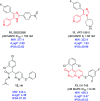Small molecule therapeutics for neuroinflammation-mediated neurodegenerative disorders
- PMID: 34223157
- PMCID: PMC8221257
- DOI: 10.1039/d1md00036e
Small molecule therapeutics for neuroinflammation-mediated neurodegenerative disorders
Abstract
Chronically activated microglia and the resulting cascade of neuroinflammatory mechanisms have been postulated to play a critical role in neurodegenerative disorders. Microglia are the main component of the brain's innate immune system and become activated by infection, injury, misfolded proteins or a multitude of other stimuli. Activated microglia release pro-inflammatory and cytotoxic factors that can damage neurons and transform astrocytes to become toxic to neurons as well. Therapeutic approaches aiming to modulate microglia activation may be beneficial to mitigate the progression of inflammatory-mediated neurodegenerative diseases. In this literature review, we provide an overview of recent progress on key microglia targets and discovery of small molecule compounds advancing in clinical trials to minimize neuroinflammation.
This journal is © The Royal Society of Chemistry.
Conflict of interest statement
There is no conflict of interest to declare.
Figures











References
Publication types
LinkOut - more resources
Full Text Sources

